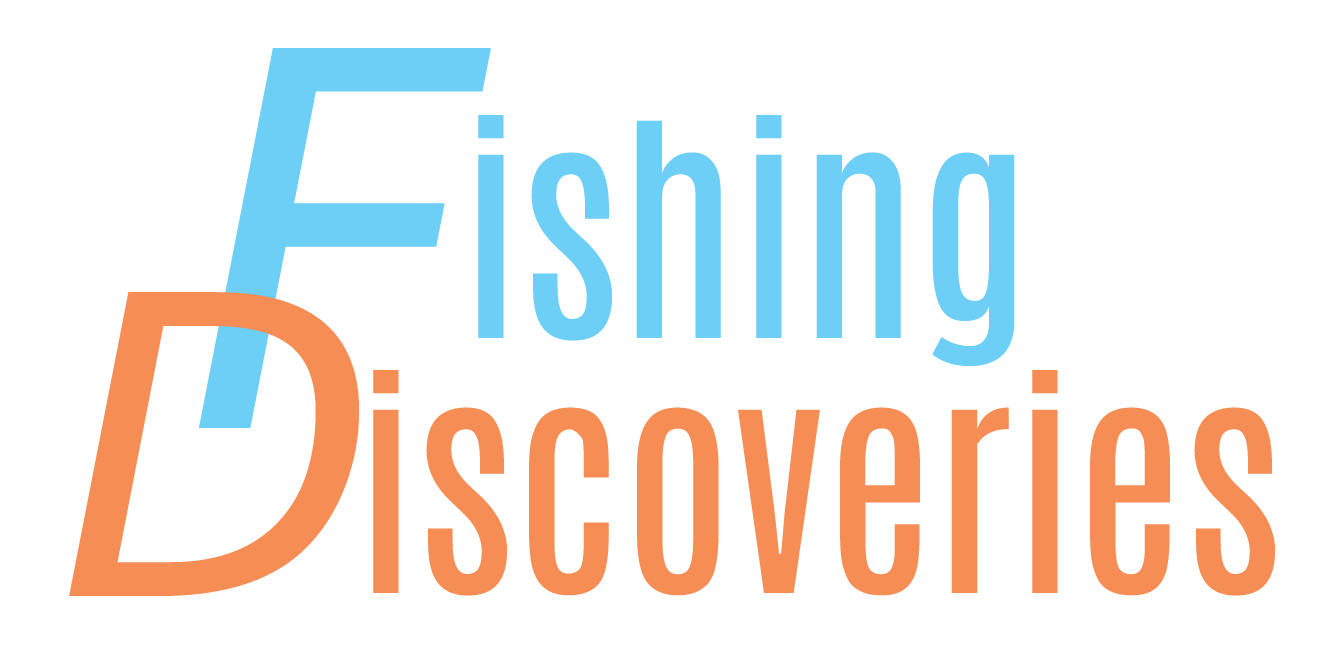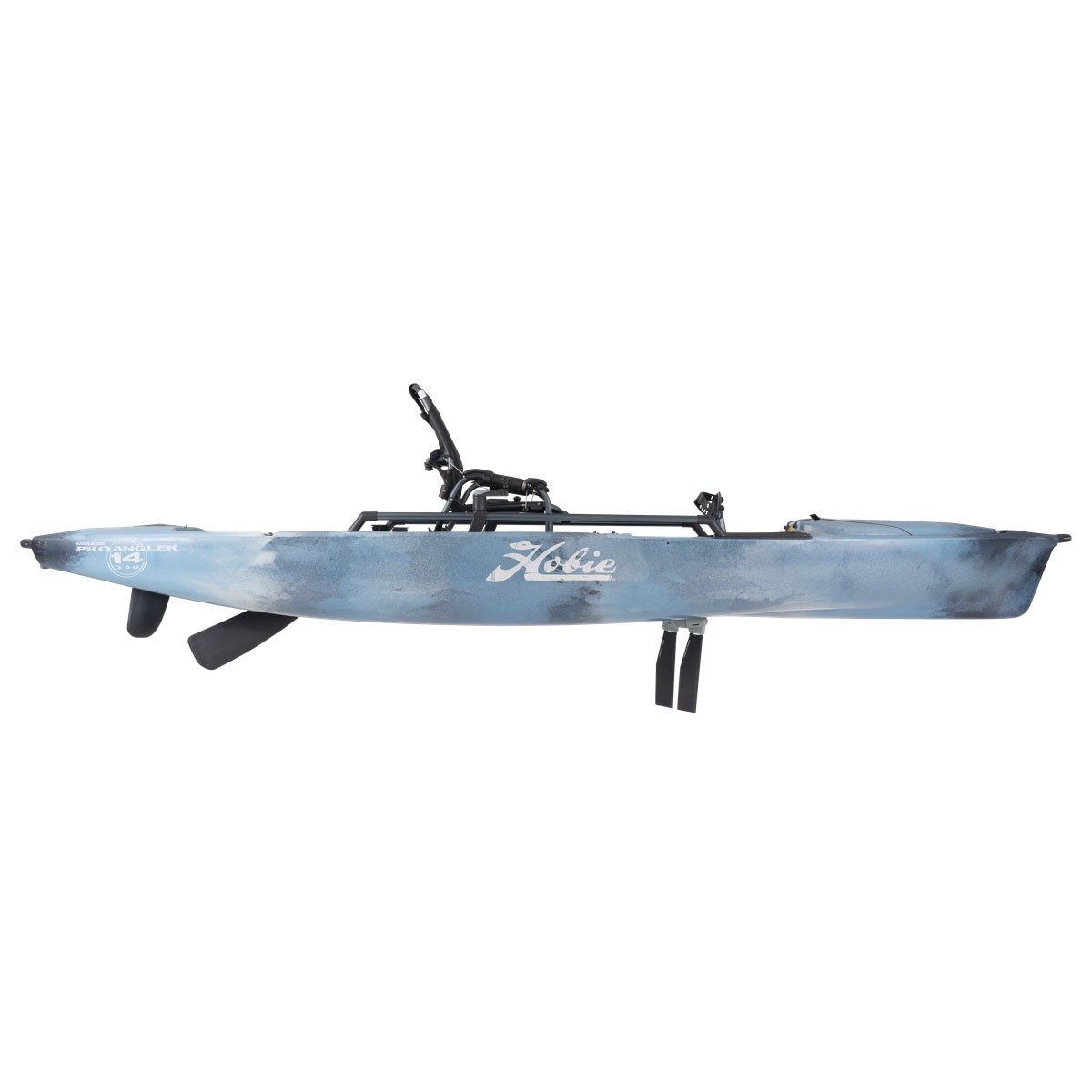Finding the best fishing kayak for your needs can be pretty complicated. Here we cover everything from understanding primary vs secondary stability to choosing your ideal drive mechanism (and everything in between)
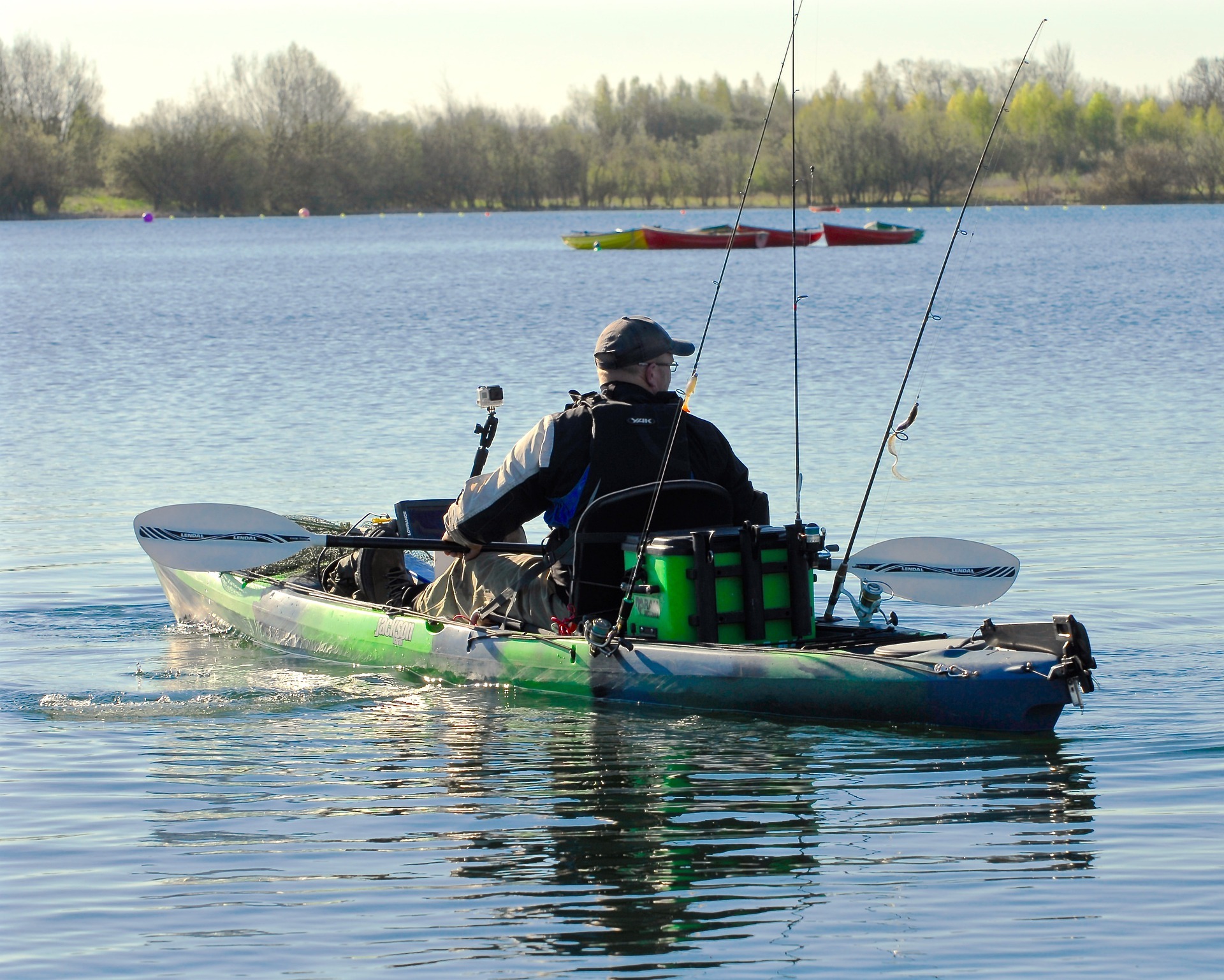
Use the Table of Contents below to jump to the section you need first:
Note: Product links in this guide have been kindly provided by affiliate partners including Amazon Associates. Qualifying purchases will earn Fishing Discoveries essential commissions with my thanks for using this support mechanism for our free and premium content.
Picks for the best fishing kayak for your needs
We'll start with some picks of specific products across the main categories of price and kayak type to save you a ton of legwork. I'll follow that up with a ton more detail on the things to consider when selecting your own best fishing kayak.
Best sit on top fishing kayak with pedal drive (Premium)
Hobie Mirage Pro Angler 14' with 360 Technology
For full details, pricing and availability check this Kayak out on Fish USA store using the button below:
High End Pedal/Sit on Top Fishing Kayak: Shave some of the Premium Costs...
Hobie Mirage Pro Angler 12 with 180 Mirage Drive
A 12-ft Hobie Mirage which replaces the 360 capability with a wider-turning circle 180 drive (which can flip instantly from forward to reverse) as shown in this demo video:
At 12-ft this model still has 500lb capacity plus many more features such as:
MirageDrive 180 with ST Turbo Fins ★ Retractable rudder system ★ Guardian Retractable Transducer Shield ★ Built-in transducer mount allows side scanning for optimal fishfinder performance ★ Pre-installed thru-hull cable plugs allow quick, no-drill, no-glue fishfinder installation ★ Dual steering (handles on port and starboard sides of the boat) ★ Two-piece paddle with on-hull storage ★ 8-inch Twist and Seal Hatch ★ Sail Mount (for separately-sold sailing kit) ★ Anchor trolley system ready ★ Vantage ST Seating ★ Horizontal Rod Storage for 4 Rods ★ Large front hatch with removable liner ★ Large rectangular hatch with Pivoting Tackle Management System ★ Livewell-ready cargo area ★ Under seat tackle storage ★ Molded-in vertical rod holders ★ Tracking Skeg ★ Mesh stowage pocket ★ Front, rear and mid-boat carrying handles ★ Deck grip pads ★ Padeye XL ★ 3-way connector for Lowrance (sold separately) with through-hull wire plugs (Backwards Compatible) ★ 2 Plano tackle boxes ★ 2 H-Rail rod racks ★ 1 H-Rail cup holder
Best Fishing Kayak: Mid Range, Sit on Top for Rivers (Paddle)
Jackson Coosa HD Fishing Kayak 2022
The Jackson Coosa HD is already a popular and top-selling stand-up fishing kayak - now the 2022 model comes with beefed-up dimensions and features. Jackson's design team updated this heavy-duty, made in the USA, fishing 'yak and made it a bit longer and wider than the original. That increased sizing makes it an even more stable fishing platform. It's most at home on rivers and also calm lakes.
At 12-ft 6" long and 425lb capacity the Coosa HD also boasts:
Dual rod tip protectors on bow for easy storage when heading into rough waters or under trees ★ Hypalon snag free paddle strap ★ Large front and smaller rear hatch with heavy duty latch system ★ Fitted gear track from bow to stern for varied rigging configurations ★ Deck pads for comfortable standing (and to keep it quiet when you drop stuff) ★ Removable center console hatch/cover with smaller dry storage day hatch (The Console is perfect to store tackle and batteries and gives you clean access to the transducer scupper. The Day hatch is a great spot to keep keys and valuables dry) ★ Trimmable Comfort seat with both hi and low settings gives you the flexibility in seating to make sure that you are always in the most comfortable position possible ★ “Dog Leash” Drag chain system built in to grab handles ★ Huge tank-well with bungee tackle box storage ★ A four-hole bolt pattern on the stern to support accessories such as the PowerPole and Torqeedo trolling motor mount adaptor ★ Dual flush mounted rod holders
See the full details (including rocker characteristics and hatch dimensions) by clicking the button below:
Best Sit-Inside Value for Money Fishing Kayak
Perception Sound 10.5 Sit Inside Fishing Kayak
A sit-inside 10ft 6" kayak with dual flush fit rod holders (available in a range of colors) and a maximum capacity of 335lb. Features include:
Adjustable foot rests for anglers of different sizes ★ Ample bungee-secured Tank-well storage on the stern ★ 2 moulded in/flush rod holders ★ Unique "stabiliser" Tri-keel hull to enhance tracking and create great primary stability ★ Storage tray in the dashboard ★ Solo mount recesses on either side of the dash ★ Large cockpit ★ UV, impact and abrasion-resistant high density polyethylene
Check Pricing and Availability on Amazon using the button below:
Best Fishing Kayak: Budget Option (Sit on Top)
Lifetime Tamarack Angler 100 Fishing Kayak
This 'yak comes highly recommended (a 4.4 out of 5 rating with over 1000 reviews on Amazon) and an incredibly low price tag. It's 10 feet long, has a maximum capacity of 275lb and a host of other features such as:
Adjustable Padded Seat Back and Seat Pad for Comfort Hatch for Added Storage Beneath the Deck ★ Two Flush Mounted Fishing Rod Holders ★
One Adjustable, Top-Mounted Fishing Rod Holder ★ Deep Hull Channels for Tracking Performance and Chine Rails for Stability ★ Front and Rear Shock Cords
★ Multiple Footrest Positions for Different-Size Paddlers ★ Front and Rear T-Handles for Easy Transport ★ Constructed of UV-Protected High-Density Polyethylene ★ Stable Flat Bottom ★ Two 6-Inch Storage Compartments in Rear and Center ★ Paddle Keeper to Secure Your Paddle to the Kayak
Now for some guidance on the whole subject of fishing kayak choice...
How do you find the best fishing kayak for your individual situation?
Choosing the best fishing kayak is like buying a car—you want something that suits your lifestyle and budget. There are many factors to consider, such as what type of water you plan to fish in, how much space you have in your garage, and how often you plan to use it.
Before making a final decision, think about your goals and identify your needs. Do you plan on catching large game species such as largemouth bass, smallmouth bass, catfish and stripers? How about smaller game species such as crappie, sunfish, perch and channel catfish? If you plan on catching both largemouth bass and smallmouth bass, you might want to look at a double-hulled fishing kayak. These boats typically offer more stability than single hull models.
If you plan to paddle mostly in saltwater, you'll probably want to choose a fishing kayak with a wide beam. This allows you to move quickly across rough waters without tipping over. A wider beam also makes it easier to keep balance while casting. It's fair to say that you need a stable kayak for safe and effective fishing.
In addition, if you plan on spending a lot of time offshore, you'll want a boat with a high freeboard (i.e. more of the boat above the water). This helps prevent you from getting wet feet during heavy weather conditions.
When selecting a kayak, make sure you're comfortable sitting upright for long periods of time. In fact, some anglers prefer sit-on-top kayaks because they allow them to remain alert even when seated - and of course comfortable seats make a huge difference. It's also crucial to understand the weight capacity requirements for your kayak - so you need to think about the weight of gear, tackle boxes, trolling motor and batteries as well as the size and number of people you plan on having aboard!
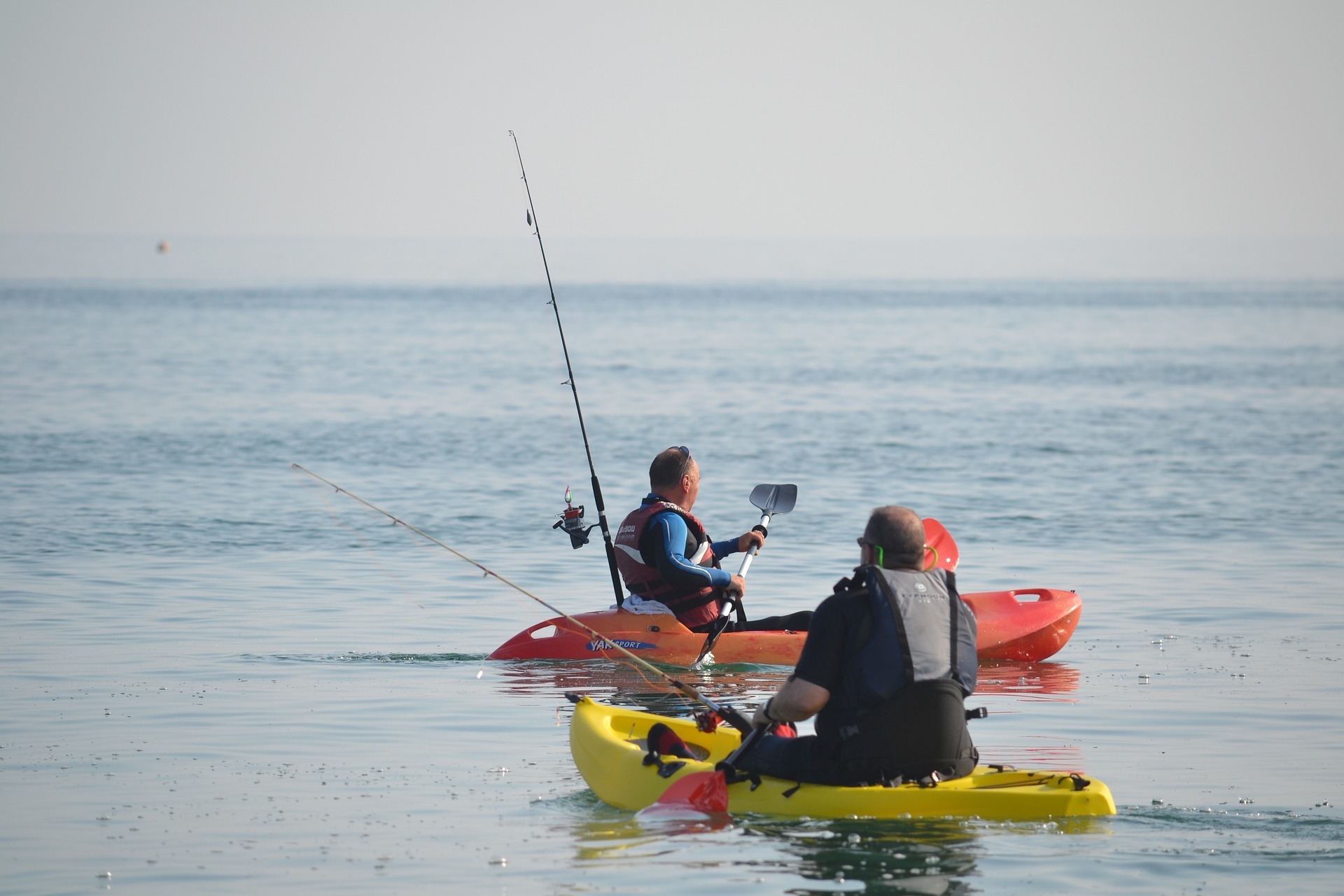
For all kayaks, it is important to understand the difference between primary stability and secondary stability:
- Primary stability (AKA initial stability) is how solid and stable a kayak is in flat water with the hull directly below you
- Secondary stability is how well a kayak will "right" itself once tipped over sideways
These factors interact and, depending on the performance needed from a particular 'yak there are different balances of those two kinds of stability needed. As an example of this, in order to have a good, solid fishing platform - primary stability is important. With that said, coastal fishing situations will make it important that your boat has enough secondary stability to right itself once tipped sideways by any wave action.
Sit on Top Fishing Kayaks (SOT)
These are probably the most common design kayaks for fishing. They give you a good fishing position and lots of space around you to arrange gear. Due to the air sealed between inner and outer hulls they are close to impossible to sink. When getting in/out, they tend to provide a very stable platform (good primary stability) and dry storage hatches are usually available. Sit on top models are wider kayaks - and usually provide plenty of options to attach fish finders, rod holders and tackle storage solutions.
It's usually a good idea to strap your gear securely - since if you do happen to capsize, there's a good chance you'll lose anything not stored inside a hatch or strapped down. Bungee storage is a good example of achieving this. However, for anyone worried about being stuck inside a capsized sit-in kayak, the sit on top models mean there's very little chance of being trapped if you are unexpectedly flipped. They are also easier to get back into once capsized.
The compromises you make to get the benefits of generous storage, maximum stability with the boat under you and overall good fishing position include the fact that wider hull designs will be slower to paddle - and require more effort to paddle by hand since longer paddles are needed. That primary stability will also make the boat feel more "tippy" in response to any wave action.
Sit-in Kayaks
One major benefit of sit-inside kayaks is the greater protection against getting wet - for yourself not only as a dry storage consideration for gear! This alone can make them an attractive option for coastal fishing applications. In addition, the lower centre of gravity of sit in (compared to sit on) means that they also have that improved secondary stability which is important in an ocean kayak. You might have to take more time thinking about fishing gear storage - but some of that can come down to choosing a sit in with a large enough cockpit area. As long as there is a suitable flat surface and enough depth beneath the mounting point - it is just as possible to fit flush mount rod holders as it would be for sit on top models.
Inflatable Kayaks
For anyone who struggles with the storage or transportation of rigid-hull kayaks I've created a separate guide to buying the best inflatable models for the kayak angler across a full range of budgets. Just click on the link to inflatable fishing kayaks here.
Overall, the most important element is to first understand what you want to do with your fishing kayak...
Pick Your Type of Kayak Based On What You Want To Do
There are many different types of kayaks that you can use for fishing. Some people like to fish from traditional sit-on-top kayaks, while others enjoy paddling around in kayaks that allow them to stand up and cast their lines. If you want to make sure you find the perfect kayak for fishing, there are a few things you should consider. Here we look at the most important factors that make each type of kayak specifically suited for fishing.
What is a Pedal Drive Kayak Good For?
Pedal kayaks have become increasingly popular over the years. They are great for fishing because you do not have to hold onto anything while paddling. You just use your legs to propel yourself forward. This frees up your hands for casting, reeling, rigging and all other aspects of managing rod, reel and fishing net. In fact, that hands-free fishing is one of the biggest selling points compared to regular kayaks,
There are many different types of pedal kayaks available today. Some even feature the optional support of electric power when you feel the foot pedals just aren't cutting the mustard! Most pedal drive kayak models, though, are purely manually driven.
Pedal-powered kayaks are usually lighter and easier to maneuver than electric motor powered kayaks. They are also much quieter than electric motors, making it easier to sneak up on fish without scaring them away. While pedal-powered kayaks aren't necessarily cheaper than electric-powered models, they do offer a lot of flexibility. You can go wherever you want to go, whenever you want to go, and even stop where you want to stop.
You can expect to find manual pedaled kayaks spanning a range of price points - some with propeller drive and others using fin-systems. A good example of this style of kayak is the Hobie Mirage Drive. This drive style is highly maneuverable (as shown in the 360 and 180 version videos in the product picks section), easy to transport, and requires little maintenance.
Electric Motor Powerpaddle Kayaks
These kayaks require a battery pack to power the motor. The batteries typically weigh around 20 pounds. If you plan on carrying it around all day long, make sure you purchase one that fits inside the cockpit area of the kayak. Some of the "trolling motor included" fishing kayaks on Amazon had very mixed reviews about performance, durability and customer service - so I did not include them in the product picks.
Electric-powered kayaks are great for fishing trips that take place over long distances. These boats are typically heavier and larger than pedal-powered kayaks, but they're also capable of carrying large amounts of gear. In addition, most electric-powered kayaks come with built-in batteries that provide power for hours upon hours of fishing. This makes them ideal for longer trips, especially those that involve traveling across rivers or lakes. You might want to bear this system in mind since it can help overcome tough currents and bad conditions - particularly in a case of solo fishing and any medical emergency when you would be unable to paddle yourself.
Where the water is deep enough, with an appropriate attachment bracket it is possible to attach a trolling motor to most kayaks - which is another route to gaining
Traditional Paddle Power!
Anglers such as Matt Nelson of the YouTube channel "NDYak Angler" are skilled paddlers who can handle rods, nets and some one-handed paddling when necessary. As well as the increased space freed up when you take a pedal drive system out of the equation, you also have great maneuverability at a much cheaper pricepoint than 360 mirage drive options. The most affordable pedal-drive systems use a rudder to steer - and this requires you to be moving along before you can change direction. With a paddle (or with 360 Mirage Drive), you can rotate on the spot - which is a big advantage on many fishing venues; particularly when fishing up against features and cover.
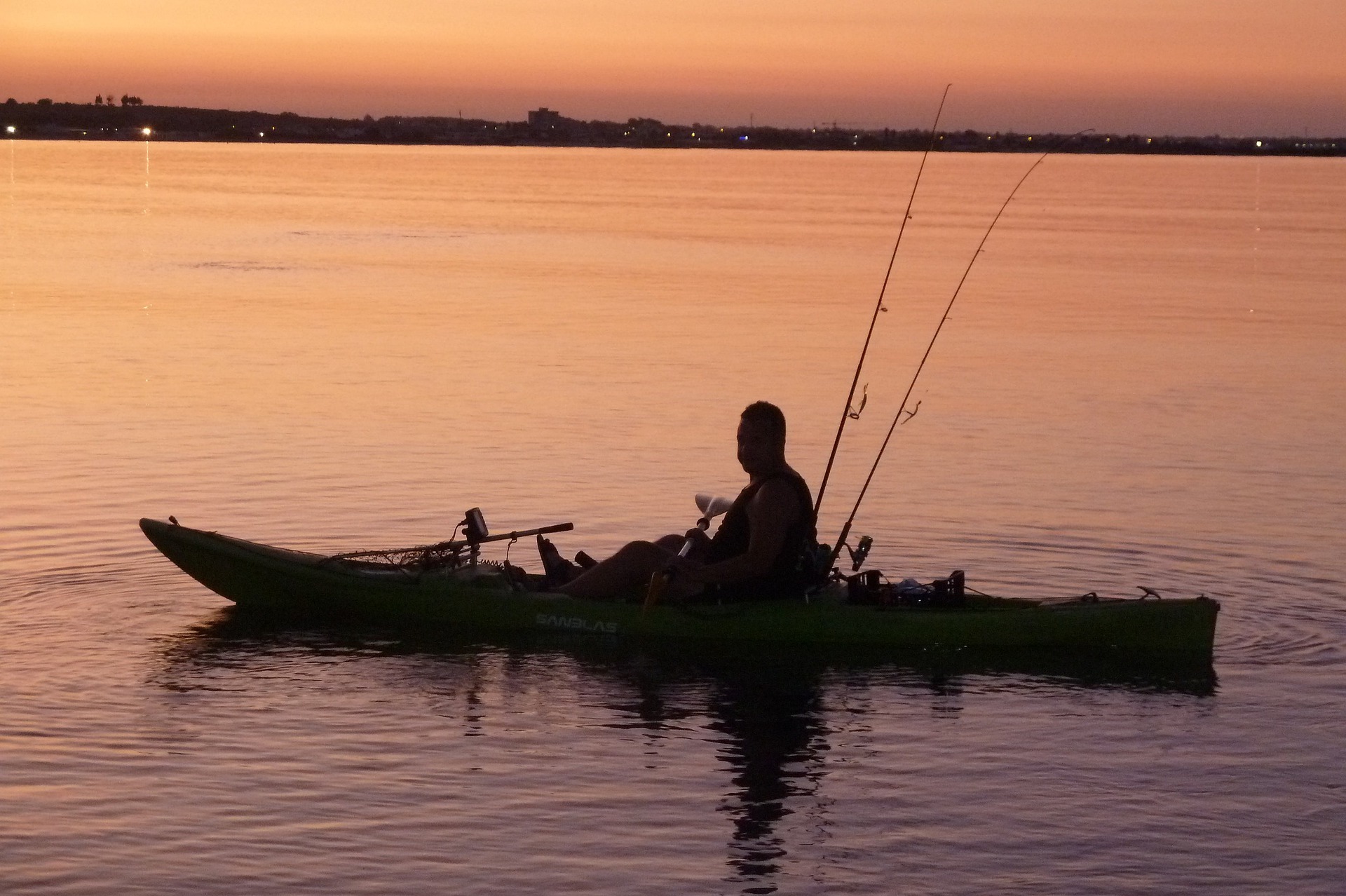
Surprisingly though, paddling by hand tends to be slower than pedal powered 'yaks (they reckon on average by about half the speed). It's undoubtedly true that most people's legs are more powerful and have better endurance compared to arm and upper body strength.
However, with additional storage space freed up by opting for paddle power over a pedal unit, you may be able to get away with a shorter kayak. That generally allows you to cover ground a bit faster - and is certainly easier to maneuver than a bigger boat. Another possible advantage is when you need to get through shallow water. For a traditional paddle kayak, it might be possible to power yourself in as little as 5" of water.
While the Hobie "kick up" function on their pedal-drive system fins will let you pass through super, shallow water - it won't necessarily maintain the same degree of propulsion you'd have with a regular paddle.
Best Fishing Kayak Accesories
On top of any electric motor or fancy pedal drive mechanism, accessory rails (sometimes called gear tracks) or customised fishing rod holder arrangements found on a modern fishing kayak, there are some items that can make life (and fishing) much easier for the kayak fisherman. In addition to my guide to the best fish finders for kayaks here, there are also the following options to consider:
